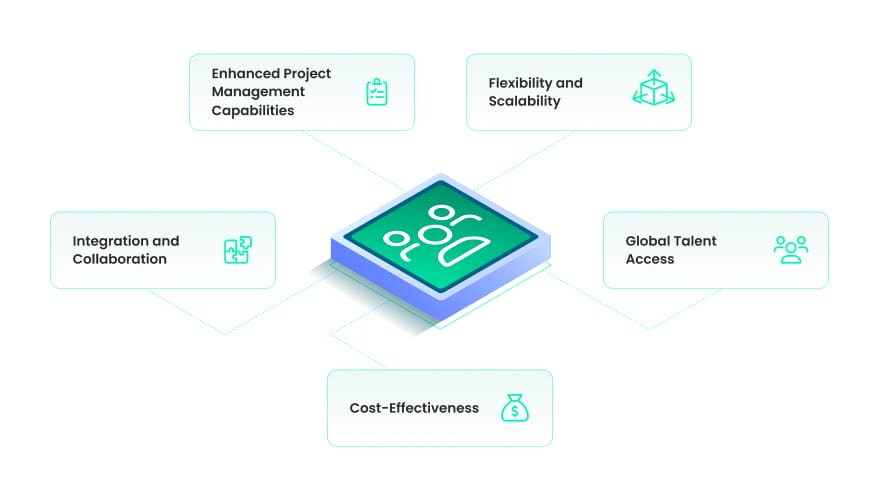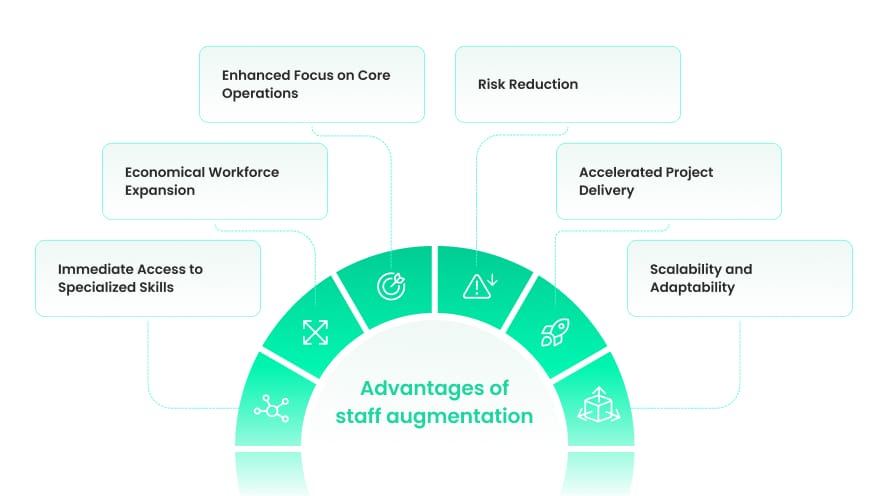What is Staff Augmentation?

Explore staff augmentation, a strategic approach enabling businesses to scale with agility and access global talent. Learn how it transforms operations and drives innovation in the fast-paced IT landscape.
Introduction
In the ever-changing landscape of information technology, organizations are on a perpetual quest to find innovative solutions for scaling their workforce, enhancing expertise, and executing projects with greater efficiency. Amid this quest, the concept of staff augmentation has emerged as a key strategy, offering a blend of flexibility and access to global talent pools that traditional hiring methods cannot match. But what exactly is staff augmentation, and how does it transform the approach companies take towards meeting their workforce requirements? This article dives deep into the staff augmentation model, detailing its services and the extensive benefits it offers to organizations navigating the complexities of today's tech-centric world.
What is staff augmentation?

At its core, staff augmentation is a dynamic outsourcing strategy that empowers companies to hire technology talent from across the globe and manage this augmented team directly. This model is distinguished from conventional hiring by its unparalleled flexibility, allowing businesses to scale their workforce in response to project demands swiftly. The primary allure of staff augmentation services lies in their ability to integrate skilled professionals into existing teams on a temporary or long-term basis, thereby filling in skill gaps without the overhead and commitment associated with permanent hires.
The Essence of the Staff Augmentation Model
The staff augmentation model is predicated on the addition of external professionals to complement an in-house team for a designated period. These professionals can be sourced internationally, catering to the project-specific requirements and the specialized skills needed. Such an approach not only expands the available talent pool but also introduces a level of flexibility in workforce management that is particularly valuable in today's fast-paced business environment. Companies can engage in staff augmentation for short-term needs to address immediate project demands or establish long-term relationships to ensure continuous support and expertise.

Flexibility and Scalability
The hallmark of staff augmentation is its unparalleled flexibility and scalability, allowing businesses to dynamically adjust their team sizes in response to the shifting demands of projects. This key feature means companies can ramp up their workforce during peak times of development or scale down when projects are completed, ensuring that staffing levels are always in perfect alignment with current needs. This agility is particularly beneficial in industries where project workloads are unpredictable, enabling businesses to manage their resources more efficiently without the long-term commitment and financial implications of hiring full-time employees.
Global Talent Access
Staff augmentation breaks down geographical barriers, offering companies direct access to a global talent pool. This feature is especially crucial in the tech industry, where specific skills can be scarce or highly sought after. By tapping into professionals from around the world, organizations can fill skill gaps with precisely the right expertise, whether it's niche programming languages, cutting-edge software development methodologies, or specialized project management skills. This global reach ensures that companies are not limited by the local talent market and can source the best individuals to meet their project requirements, driving innovation and competitive advantage.
Cost-Effectiveness
One of the most attractive features of staff augmentation is its cost-effectiveness. By augmenting their staff with external professionals, companies can significantly reduce the costs associated with recruitment, onboarding, benefits, and other expenses tied to permanent employment. This model allows for a direct allocation of resources to specific projects, ensuring that every dollar spent contributes directly to business objectives. Moreover, the flexibility to adjust team sizes means that companies are not burdened with excess staff during downtimes, leading to more efficient budget management and reduced financial waste.
Integration and Collaboration
Staff augmentation services are designed to ensure that augmented staff seamlessly integrate into existing teams, fostering a collaborative environment that aligns with project goals and company culture. This integration is facilitated by various tools and methodologies that support remote work, project management, and communication, ensuring that external professionals become an effective extension of the in-house team. The emphasis on collaboration means that augmented staff can quickly adapt to the workflows and processes of the company, leading to cohesive teamwork and a unified approach to achieving project milestones.
Enhanced Project Management Capabilities
Augmented staff can bring a fresh perspective and advanced project management methodologies to the table, enhancing the overall efficiency and productivity of projects. With experience in diverse environments and industries, these professionals can introduce best practices and innovative solutions to common project challenges, streamlining processes and improving project delivery timelines. This infusion of expertise can be particularly valuable in complex or large-scale projects that require meticulous coordination and management.
Advantages of Staff Augmentation

Immediate Access to Specialized Skills
Staff augmentation provides companies with the agility to swiftly address project needs by acquiring specialized talent for specific tasks. This key advantage ensures not only the efficient completion of projects but also their execution with a high degree of expertise. The ability to quickly bring in experts with the exact skill set required, be it emerging technologies, niche programming languages, or specialized industry knowledge, is invaluable. This rapid access to talent helps maintain project momentum, reduces the learning curve associated with new technologies, and ensures high-quality outcomes that meet or exceed project specifications.
Economical Workforce Expansion
The staff augmentation model is celebrated for its cost efficiency, allowing organizations to dynamically scale their teams in alignment with project demands without the burdens of fixed employment expenses. This model sidesteps the need for long-term salary commitments, extensive benefits packages, and the costs associated with hiring and onboarding permanent employees. By utilizing staff augmentation, companies can convert fixed labour costs into variable costs that directly correlate with project needs, offering a more efficient allocation of resources and significantly lowering overhead costs.
Enhanced Focus on Core Operations
By leveraging staff augmentation services, companies can dedicate a larger share of their resources and attention to core business activities. This strategic reallocation enables a sharper focus on areas that drive business growth, such as product development, customer service, and market expansion. The infusion of external talent handles project-specific tasks, allowing internal teams to concentrate on strategic goals and innovation. This focus can lead to the development of new products and services, improved operational efficiencies, and a stronger competitive position in the marketplace.
Risk Reduction
Staff augmentation presents a strategic approach to mitigating employment-related risks, particularly those associated with the fluctuating nature of project work and market demands. It offers organizations the flexibility to modulate their workforce in response to project cycles and economic conditions, minimizing the financial and legal risks of fixed employment contracts. This model ensures that companies can navigate periods of uncertainty with greater agility, reducing the risk of overstaffing during downturns and swiftly scaling up when opportunities arise, all without the long-term commitments that can burden an organization's agility and financial health.
Accelerated Project Delivery
An often overlooked advantage of staff augmentation is its impact on project timelines. With the ability to quickly onboard skilled professionals who can hit the ground running, companies can significantly accelerate their project delivery times. This speed is critical in industries where time-to-market can be a decisive factor in the success of a product or service. Staff augmentation enables organizations to meet tight deadlines, respond to customer needs more rapidly, and capitalize on market opportunities as they arise. The result is not just faster project completion but also improved customer satisfaction and a stronger competitive edge.
Scalability and Adaptability
Staff augmentation offers unparalleled scalability and adaptability, empowering businesses to respond to changing market conditions, project scopes, and technological advancements with ease. This flexibility is critical for staying competitive in today's fast-paced business environment. Companies can scale their workforce up or down without the complexities associated with permanent hiring or layoffs, ensuring that they have the right talent in place at the right time. This scalability extends beyond numbers to include skill sets, with staff augmentation providing access to a broad spectrum of capabilities that can be tailored to the evolving needs of projects and business objectives.
Organizational Growth and Adaptability
Driving Innovation and Securing a Competitive Edge
Staff augmentation serves as a powerful lever for propelling innovation and securing a competitive edge in today's fast-evolving market. By integrating highly skilled external professionals into existing teams, organizations gain access to diverse insights and cutting-edge expertise that can spark transformative ideas and accelerate the development of groundbreaking products and services. This strategic infusion of talent not only enriches the organizational knowledge pool but also introduces fresh perspectives that challenge conventional thinking and foster a culture of continuous innovation. As companies navigate the complexities of the digital age, the ability to rapidly adapt and innovate becomes a key differentiator, positioning them at the forefront of their industries.
Enhancing Organizational Resilience through Strategic Flexibility
The dynamic nature of the staff augmentation model imbues organizations with a level of strategic flexibility that is critical for building a resilient workforce. In an era marked by rapid technological change and fluctuating market demands, the capacity to swiftly adjust staffing levels and skill sets is invaluable. Staff augmentation enables companies to respond with agility to new opportunities and challenges, ensuring that they are equipped with the optimal mix of talent to navigate the future. This adaptability is foundational to resilience, empowering organizations to thrive amidst change and uncertainty by maintaining operational continuity and strategic momentum.
Conclusion
Staff augmentation stands as a transformative strategy in the realm of information technology, offering organizations a flexible, efficient, and strategic pathway to scaling their workforce, accessing specialized skills, and enhancing project outcomes. By tapping into global talent pools and integrating skilled professionals seamlessly into existing teams, businesses can drive innovation, accelerate project delivery, and achieve a competitive edge in the fast-paced digital landscape.
This model not only enables companies to navigate the complexities of modern projects with agility but also provides a cost-effective solution to the challenges of recruitment, scalability, and operational efficiency. The synergy of staff augmentation with nearshore strategies further amplifies these benefits, offering real-time collaboration and cultural alignment that traditional outsourcing models cannot match.
In conclusion, as organizations continue to seek adaptable, reliable, and efficient ways to meet their evolving project demands and business objectives, staff augmentation emerges as a key enabler. It offers a compelling solution that addresses the dynamic needs of the IT sector, fostering a culture of innovation and resilience that is essential for success in today's competitive environment.




